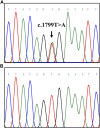Changes in antioxidant status and DNA repair capacity are corroborated with molecular alterations in malignant thyroid tissue of patients with papillary thyroid cancer
- PMID: 37692064
- PMCID: PMC10484572
- DOI: 10.3389/fmolb.2023.1237548
Changes in antioxidant status and DNA repair capacity are corroborated with molecular alterations in malignant thyroid tissue of patients with papillary thyroid cancer
Abstract
Introduction: Papillary thyroid cancer (PTC) accounts for approximately 80% of all thyroid cancer cases. The mechanism of PTC tumourigenesis is not fully understood, but oxidative imbalance is thought to play a role. To gain further insight, this study evaluated antioxidant status, DNA repair capacity and genetic alterations in individuals diagnosed with benign thyroid lesion in one lobe (BTG) and PTC lesion in another. Methods: Individuals with coexisting BTG and PTC lesions in their thyroid lobes were included in this study. Reactive oxygen species (ROS) level, ABTS radical scavenging activity, ferric reducing antioxidant capacity, glutathione peroxidase and superoxide dismutase activities were measured in the thyroid tissue lysate. The expression of selected genes and proteins associated with oxidative stress defence and DNA repair were analysed through quantitative real-time PCR and Western blotting. Molecular alterations in genomic DNA were analysed through whole-exome sequencing and the potentially pathogenic driver genes filtered through Cancer-Related Analysis of Variants Toolkit (CRAVAT) analysis were subjected to pathway enrichment analysis using Metascape. Results: Significantly higher ROS level was detected in the PTC compared to the BTG lesions. The PTC lesions had significantly higher expression of GPX1, SOD2 and OGG1 but significantly lower expression of CAT and PRDX1 genes than the BTG lesions. Pathway enrichment analysis identified "regulation of MAPK cascade," "positive regulation of ERK1 and ERK2 cascade" and "negative regulation of reactive oxygen species metabolic process" to be significantly enriched in the PTC lesions only. Four pathogenic genetic variants were identified in the PTC lesions; BRAF V600E, MAP2K7-rs2145142862, BCR-rs372013175 and CD24 NM_001291737.1:p.Gln23fs while MAP3K9 and G6PD were among 11 genes that were mutated in both BTG and PTC lesions. Conclusion: Our findings provided further insight into the connection between oxidative stress, DNA damage, and genetic changes associated with BTG-to-PTC transformation. The increased oxidative DNA damage due to the heightened ROS levels could have heralded the BTG-to-PTC transformation, potentially through mutations in the genes involved in the MAPK signalling pathway and stress-activated MAPK/JNK cascade. Further in-vitro functional analyses and studies involving a larger sample size would need to be carried out to validate the findings from this pilot study.
Keywords: benign thyroid goitre; oxidative DNA damage and repair; papillary thyroid cancer; reactive oxygen species; signalling pathways; whole-exome sequencing.
Copyright © 2023 Eng, Abdul Aziz, Ng and Mat Junit.
Conflict of interest statement
The authors declare that the research was conducted in the absence of any commercial or financial relationships that could be construed as a potential conflict of interest.
Figures






References
-
- Arnett S. D., Osbourn D. M., Moore K. D., Vandaveer S. S., Lunte C. E. (2005). Determination of 8-oxoguanine and 8-hydroxy-2'-deoxyguanosine in the rat cerebral cortex using microdialysis sampling and capillary electrophoresis with electrochemical detection. J. Chromatogr. B 827 (1), 16–25. 10.1016/j.jchromb.2005.05.036 - DOI - PMC - PubMed
LinkOut - more resources
Full Text Sources
Research Materials
Miscellaneous

